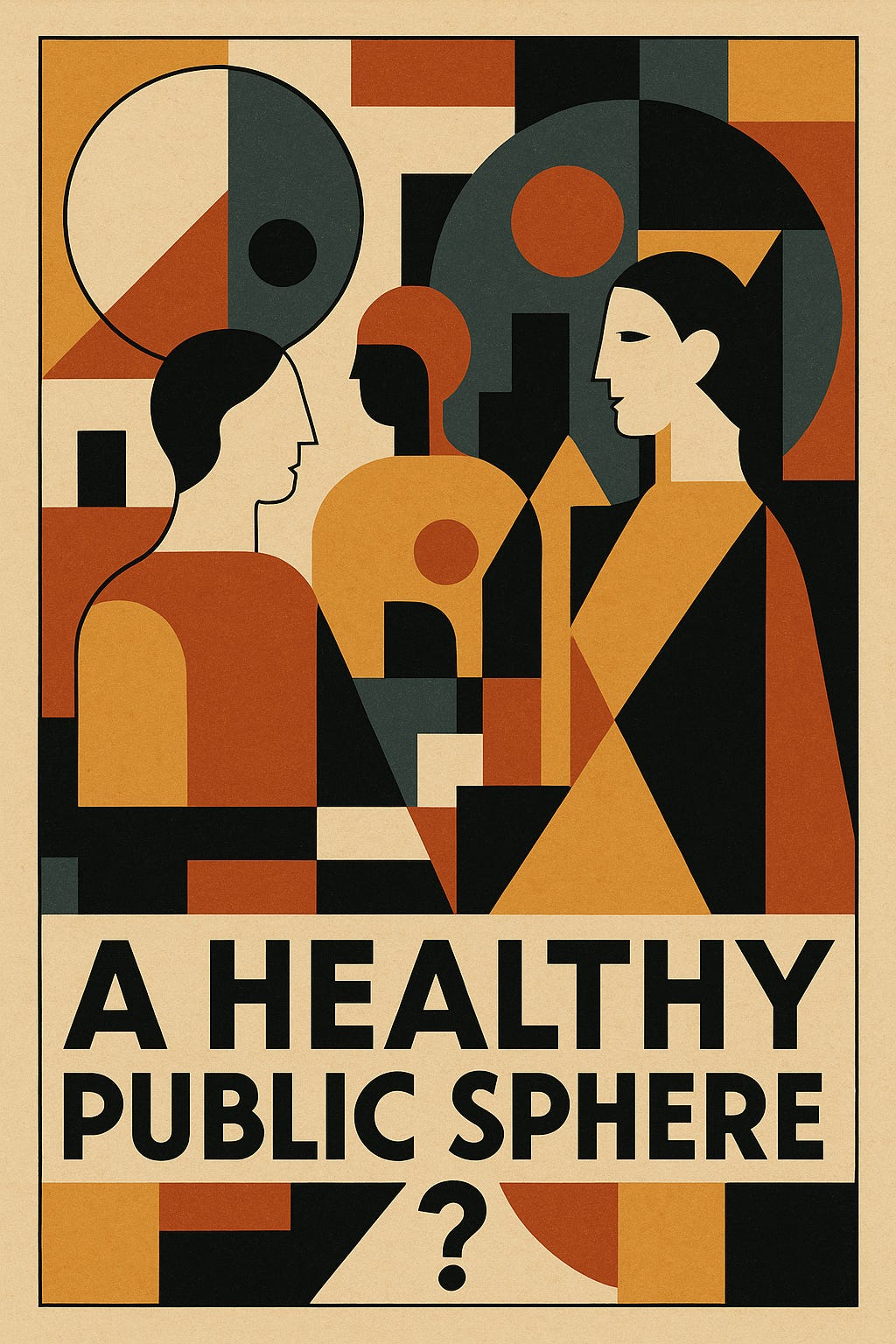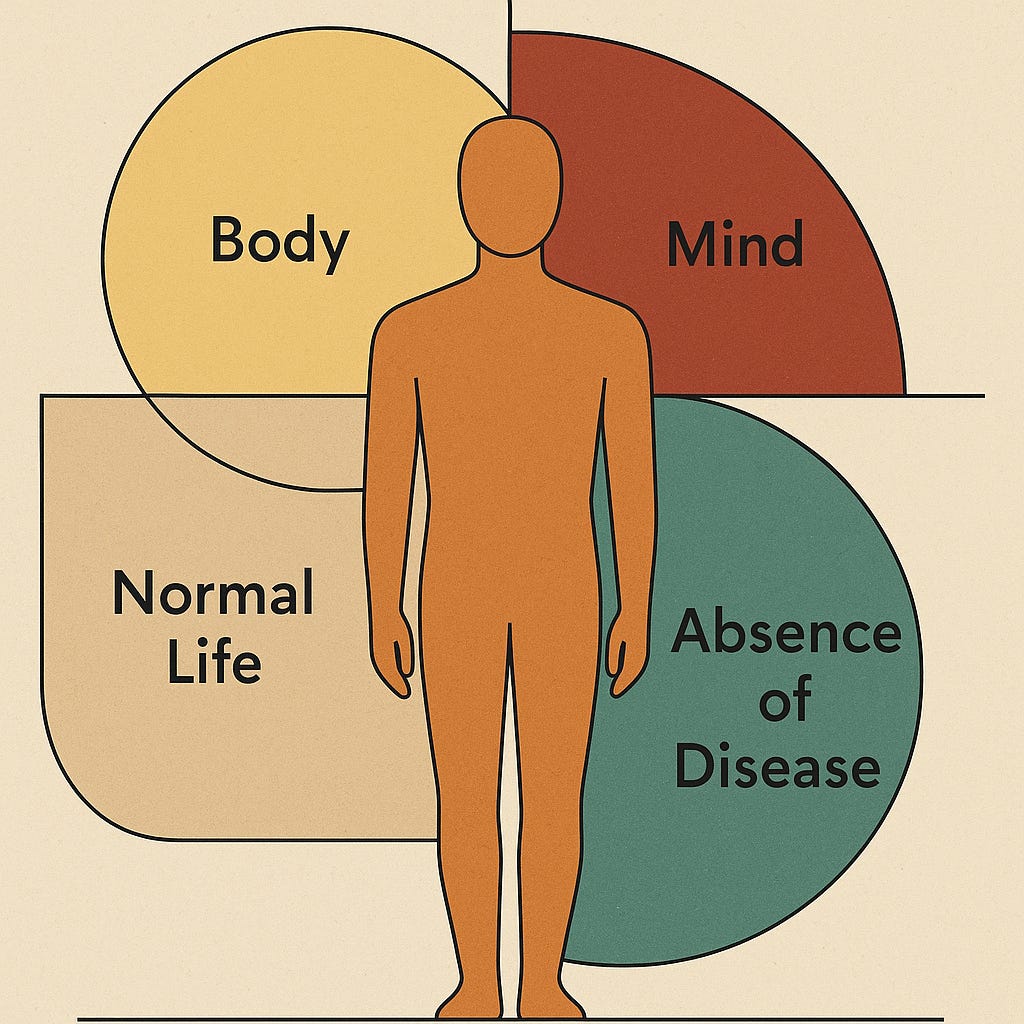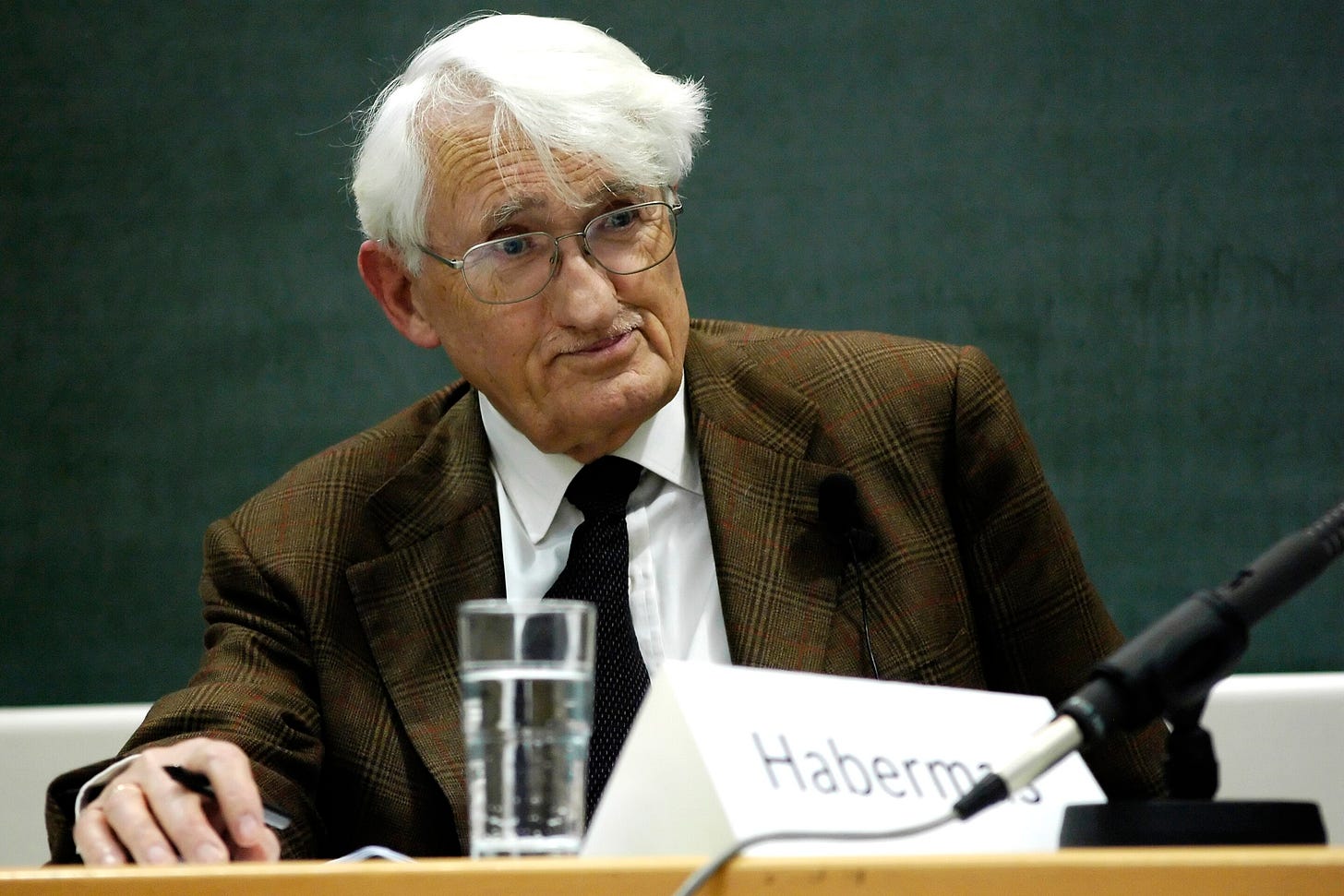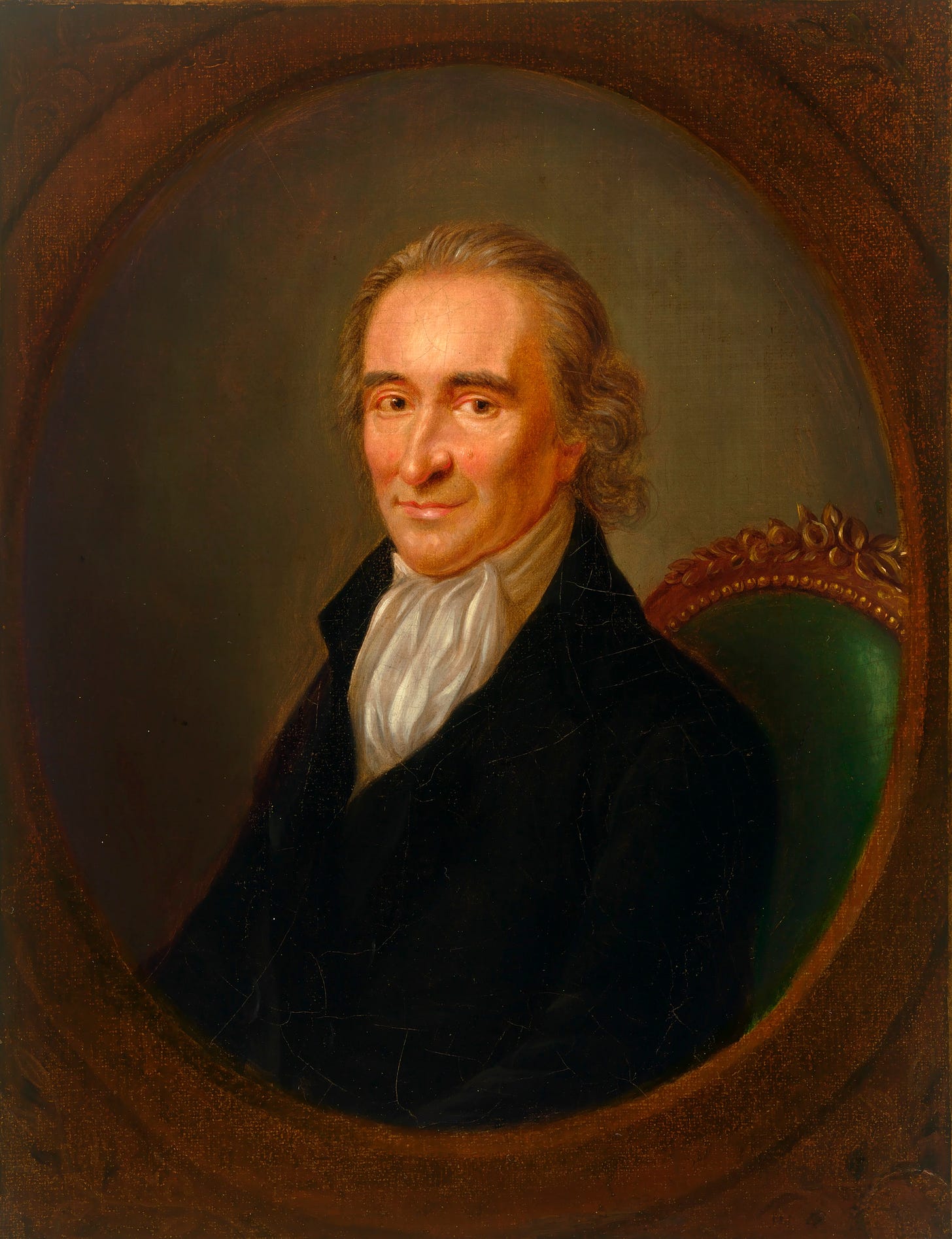Unpredictable Patterns #128: What is a healthy public sphere?
Why desired outcomes need to play a larger role in legislative work, co-written with Fredrik Erixon
Dear readers!
This week’s essay is a set of reflections about the root problem that underlies the question of mis- and disinformation, populism and propaganda: what does a healthy public sphere really look like? And did we ever have one? I have had the great pleasure to co-write this with Fredrik Erixon, founding director at the think tank ECIPE, author of several reports and books and generally one of our most rigororus thinkers on international policy, legislation and history. We hope you enjoy it, and let us know what you think.
A healthy public sphere?
Everywhere in the debate about the Internet, social media and new technology we find demands for content moderation, concern around mis- and disinformation as well as the erosion of a shared baseline of facts. The European Union, the United States and other countries have all raced to figure out how to regulate online content, and companies have stood up massive departments focused on "Trust and Safety" tasked to deal with the adverse effects that different kinds of contents may have.
All of these efforts share a key assumption: that the public sphere is crumbling under technological change. Regulation, both legislation and self-regulation, aim at restoring the public sphere to a healthy state, but we have very little discussion about exactly what that state looks like, let alone how we could get there and how distant we are from it now. It begs the question: What is a healthy public sphere?
Healthy, public, and square
One of us was privy to a discussion with a few technologists interested in applying artificial intelligence and other related technologies to medicine, and the discussion started off as most such discussions start off: looking at which diseases we should prioritise curing, if we can, and how we select the right projects to work on. Mid-discussion, however, one person interjected that maybe one problem with the entire discussion was that we do not have a good model of what a healthy human being is and how a healthy state is described.
At first this seemed preposterous. Of course we know what health is: it is the, um, absence of disease? Well, the person said, what about blindness? Can you be healthy and blind? What about depression? Can you be healthy and depressed? Is health about a state of the body, or a state of mind? What about the case where a doctor medicates a patient to address a bodily problem, but this medication makes the patient to lose certain capabilities – or even becoming a different person? Is health the same as preserving you as you prefer to be - be it blind, depressed or over-weight - and make sure you can live a normal life with all the degrees of freedom associated with our conception of a good life? Or is it the active elimination of all conditions that in some way reduce a set of functionalities that we define as healthy?
It soon became obvious that the concept of health is far from simple. For a very large part of the population, health is neither a static nor a monolithic concept. The reality of life, especially of aging life, is that health and unhealth are parallel phenomena. And aren’t these conditions true for the health of the public square as well? It is hardly likely that there is a state when the health of the public debate is just how it should be or how most people want it to be. Just like the balance between health and unhealth for an individual or a population changes a lot, the public debate will include parallel and changing conditions and outcomes.
Similar principal observations can also be made about public and square. As soon as we try to fill them with some definite meaning, their ambiguities get clearer and we end up with propositions that are, to say the least, dubious. Let's look at a couple of different but flawed attempts to define a healthy public sphere.
One way to define a healthy public sphere is that it is one that deepens democracy rather than erodes it. This seems innocuous and tails with various democratic standards. But what does it really mean? One interpretation is that it would include full viewpoint diversity on all matters of importance. But a different interpretation is that viewpoint suppression is necessary, especially of views that are deemed to challenge the deepening of democracy. Quite often, we end up saying something like "if we had a healthy public sphere, we would not see the rise of far right parties that do not respect democracy" or "a healthy public sphere is one in which there is no polarization". These statements betray a view of the ideal public sphere as a Habermasian consensus mechanism. The function it plays is simply to ensure that a democratic consensus is forged, and that issues are resolved within pre-existing political limits of the acceptable. In this view, health means homeostasis, and the key function we look for in the public sphere is conservative: that it conserves the institutions of democracy, the existing party structure and the ideological analyses of these parties as the available choices for the citizens.
Hey, you may say, that does not sound too bad! Why should we not opt for that as the definition of health here? Well, one answer to that question is that if this had been a healthy public sphere historically, it would have conserved whatever society that we had back then. To start with, democracy and liberal rights may never have arisen because, obviously, they disturbed political peace, exacerbated polarization, and their emergence generally challenged the climate of established opinion. If preservation is the main or sole priority for a healthy public square, it is likely that health will wither away very quickly. A healthy public sphere needs to allow for social, viewpoint, and institutional change.
So, let's follow that observation: we now define a healthy public sphere as one that allows for social change and deepens democracy. Sure, we want our public sphere to allow for the extension of rights to groups that have previously been denied them, and we want to ensure that society becomes more and more permissive socially. But we also want to make sure that the public sphere really entrenches democratic values. So, the formula is consensus and gradual change, under democratic frameworks.
This, again, seems fine - until you ask: who sets the democratic values? If we allow citizens to do so, we must allow for them to change their minds, expand or reduce inclusion – and even reject some democratic institutions. And if it is not the citizens - then who? What we see here is a key risk in the way that we think about the public sphere: we want the public sphere to produce better citizens, and by better we mean citizens that believe most of the things we also believe, and dissent on the margins only.
Any definition of a public sphere that judges its health by the beliefs the citizens end up having is a public sphere whose primary function is not the production of consensus, but the manufacturing of consent.
Let's change tack and look at an alternative: maybe a healthy public sphere is one that shuns consensus and instead agonistically produces sharply differing views, but agrees to let democratic processes resolve them. All views are allowed, no values need to be preserved or inculcated, except the procedural value of the vote, rather than violence, as the mechanism of resolution of our disagreements.
Is this a viable definition of a healthy public sphere? For sure! But it contrasts sharply with the first, and in this version the public sphere does not need content moderation or the equivalent of the EU’s Digital Service Act. In fact, promoting sharp viewpoint conflicts is a greater good than reducing them.
However, this version of what it means for the public sphere to be healthy also has deep problems. In the first place, cultures of agonism are brittle: if we do not agree to stick to the vote and descend into violence we have a problem, and if the views expressed are such that they conflict with certain basic values that we believe should be inalienable, then this version of the public sphere is anything but healthy. Moreover, it doesn’t not follow from basic principles of rights and tolerance that viewpoint conflicts are universally desirable or an intermediate value to be maximized. The public square is populated by private actors who have their own boundaries and limits to what they accept and tolerate in their square. For instance, social media forums for Liverpool Football Club are not accepting of supporters of Manchester United making conflictual claims against Liverpool. Likewise, a platform or a newspaper are private actors that have their own standard of what can and should be published: their private rights can hardly be respected if they are also forced to carry all sorts of views in the spirit of promoting more agonism.
This leads us to a fundamental problem in defining a healthy public sphere - one part of the definition needs to be what is up for discussion. Are discussions about eugenics indicative of a healthy public sphere or not? Here views diverge sharply: some will say that a public sphere's health is to be found in how robustly it can deal with such discussions and resolve them in favor of the values enshrined in the declaration of human rights, others will say that a healthy public sphere defines some issues as off-limits from the start, as not to open the door to old evils that we have vanquished once.
The difference is one of perimeter defense versus defense in depth when it comes to whatever set of values it is we want to defend. Is a healthy public sphere more like a shell that shuts out some organisms, or is it more like an immune system that can deal with all kinds of attacks on the organism in depth?
A functional approach: what is a health public square for?
A different functional approach to a healthy public square may be more useful. Obviously, the public square reflects constitutional liberalism but there isn’t necessarily one certain essential definition of a healthy public square that is a prerequisite for a liberal society to prevail. Nor do governments land in adequate positions when they take measures that are specific to certain medias or squares – like advancing content moderation policies on social media. A healthy public square has certain qualities but most of them are based on other institutions and actors than media itself.
All societies have institutions that act like arbiters of the public square. Two things are unique about modern liberal societies in this regard. The first defining character is that arbiters are conditional. They are institutions that are trusted and given a certain status because they may not sit on the ultimate truth themselves, but they have a professional method designed to getting closer to it. For decades and decades, they have been milieus that have fostered a climate of openness and a method for rooting out corrosive behaviour – false claims, arbitrary statements, charlatans and whiskey priests, bad-faith and manipulative assertions, to name just a few.
The second unique character is that these institutions are not part of the executive. They are institutions such as courts, journalism, and the universities where people are mandated to seek the truth and to uphold a high standard of ethics and loyalty to a method. They have for long been integral parts of a healthy public square, and it is obvious when they are not – either because they and their professional methods are shunned from the public square, or when they deviate from their own standards. The result we get then is a public square that is ripe with suspicion and that is lacking in trust and acceptance of any form or arbiter.
A functional approach to a healthy public square would start from this premise: one of its purposes – perhaps the most important one in an open liberal society – is to reduce suspicion. A healthy public square features the standards of the conditional arbiters and promotes a culture of accountability that is applied just not to power but also those aspiring to shape the public square. It is not about adding a professorial culture or having abstract academic theories as guide. Nor is it a monolithic approach based on the idea that there is one ring to rule them all. It is to promote institutions and environments that are trusted as conditional arbiters and encourage their professional standards to influence the public square. It is, of course, to promote the standards of Enlightenment pursuits.
Contemporary Western public squares are saturated in suspicion. There is a place here to discuss the responsibility of social media, but the fundamental problem seems rather to be that fewer people trust the old conditional arbiters. The technology and sociology of the public square changed, but some institutions did not survive this transition without falling prey to the suspiciousness and the behaviour it could, functionally, help to cure. Courts in some Western countries are increasingly encountering suspicion – notably the United States. But it has spread much wider. Take for instance the AfD party in Germany – which initially grew out of frustration with EU treaties on the common currency and attendant constitutional rules in Germany that were supposed to protect against a transfer union or euro-wide monetizing of public debt. These rules may have been good rules or bad rules – the point here is not to share an opinion about fiscal and monetary policy – but it is understandable that many find it difficult to suppress the suspicion that, in some instances, courts or rules can be dismissed if the right people don’t like them.
Suspicion of media and universities is more obvious. Unfortunately, it is partly also deserved. Many notable media are obviously lacking in the standards of journalism and are resorting to a culture of sensationalism or viewpoint tribalism. Even in the bigger media houses, editors have been cut out to save resources and proper journalism has often been sidelined to make space for columns and editorialized views. As became obvious during the pandemic, many established and previously trusted media institutions have partly discarded the method of journalism and gradually become mouthpieces of certain views and institutions. Regrettably, they also adopted a finite view of science: it is a domain that has developed a final view. In this iteration, there is always one authoritative answer from science and those daring to venture a different view – even if it is also based on experience from and the logic of science – could be treated as heretics. Regrettably, many scientists and scholars that frequently feature in news reporting in matters like a pandemic fails to adhere to their own standard. They preach a certain conclusion rather than humbly observing the evolving nature of science and caution against reading to much into what is perceived as established knowledge.
It is not the first time in modern history that the public square is unhealthy because of proliferating suspiciousness. Just like with questions over health in body and mind, there have been always parallel streams in the public square flowing to or away from conditional arbiters. Many societies now feature the extremes of the left and the right that infuse the public square with manipulative behaviour and that inflate something out of proportion. They use social media and new platforms, but it is principally not technology that provide them with airtime and attention. They have grown because traditional conditional arbiters have been decimated or don’t command sufficient authority. This was also true in the past – and some institutions that were arbiters, like the Church, never recovered. However, many arbiters have recovered (e.g., physics after Hiroshima, medicine after eugenics) and yet again invited trust.
A way forward?
A functional approach is useful for approaching questions about the public square and what good-faith actions that can be taken to make it healthier. Our intention has not been to resolve all questions and relevant aspects of a healthy public square - but to suggest that it needs to be asked, especially in Europe, and that the interesting answers are rarely to be found in narrow pursuits of specific media or social media regulation. Legislation that seeks to protect something needs to be clear about what the object of protection is, and what state of that object is being protected.
In Europe, a Digital Service Act without a clear statement of what health is being restored or preserved risks becoming a threat to the future of the public sphere. As long as those that are shunned by the implicit concept of health can point to their exclusion, they will be able to continue to attack and erode the public sphere - or worse: create their own splinter version.
And this is an important aspect of the health of a public sphere – its relative unity and cohesion. A public sphere that dissolves into tribal bubbles based on ideological taste, rather than any interest in fact, is ultimately broken. This is not to say that the public sphere needs to be a single conversation – but there needs to be a fundamental cohesion between various conversations, and a realization that the key to a healthy policy and public square is being able to shift from the particular to the general and back again.
Restoring trust in conditional arbiters are of fundamental importance for making the public square healthier. Without them, citizens can fall prey to manipulators and charlatans, but they can also resign and conclude, rationally, that there is no point to pursue active citizenship and practice their agency. The functional purpose of the public square is to reduce suspicion and make people active subjects in liberal societies. Suspicion as Thomas Paine once write, is the “bane of all good society”.
Thanks for reading!
Fredrik & Nicklas





